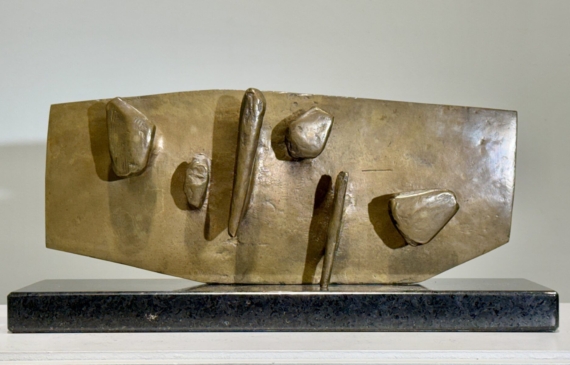

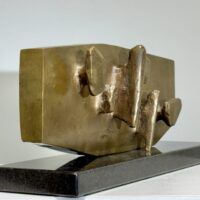
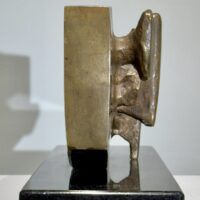
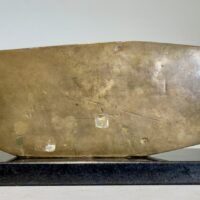
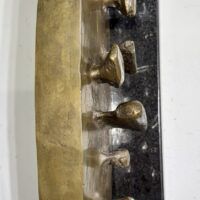
Kenneth Armitage (British, 1916-2002)
Model for a Large Work (Version A), 1962
Bronze, natural patina
6 ½ H. x 16 W. x 4 D. inches
Kenneth Armitage was a renowned post-war British Sculptor known for his expressionist human figures in bronze, often as one singular form in motion. These sculptures are often elongated, simple, and playful with a focus on emotions expressed through the body.
Born in 1916 in Leeds as William Kenneth Armitage, his artistic influences were varied. He found inspiration from nature in Leeds, in his mother’s home in County Longford in the Irish Republic, and from Egyptian and Cycladic sculptures at the British Museum.
In 1934 he was awarded a scholarship for Leeds College of Art; however, this school did not place an emphasis on sculpture. So, in 1937, he attended the Slade School in London to be trained in sculpture. Here he saw himself as a carver, but he rejected this title later in his life and went so far as to destroy them in the 50s.
In World War II, Armitage served in the British Army, the Royal Artillery, beginning in 1939. After his military service he taught at the Bath Academy of Art from 1946 to 1956. Here he was the head of the sculpture department. During this time, from 1953 to 1956, Armitage was the first university artist in residence at the University of Leeds, where he was awarded the Gregory Fellowship.
It was in his 30s when he began to gain recognition. One factor in his rise to fame was his successful one man show at Gimpel Fils, a gallery in London. As his work matured he established his figurative human sculptures, made up of flat surfaces, perhaps as a reaction to Henry Moore’s three-dimensional work. Into the 1960s, Armitage changed with the style of art at the time. His work became larger, less and frontal and he began to use mediums like plastic and spray paint.
In 1960 to 1963 Armitage worked on the central facade for the Chateau Mouton Rothschild near Bordeaux. He also traveled the world as a visiting professor. In 1964 he taught at the University of Caracaras in Venezuela, in 1970 he taught at Boston University, and from 1974 to 179 he was a visiting tutor at the Royal College of Art.
His work slowly began to combine drawing and sculpture together. And at the end of his career he created more natural sculptures.
In 1994 he was elected to the Royal Academy. And in 2001 his sculpture, Both Arms, was erect in Millennium square in Leeds and unveiled by Nelson Mandela. Another sculpture of his was erected in Leeds, in city square, post-mortem in 2018.
He died in 2002 on January 22nd at the age of 85.
His exhibitions include: the Artcurial in 1985 Paris, Seoul Olympics in 1988, Yorkshire sculpture Park in 1996 and the Millennium Sculpture Exhibition in Holland Park in 2000.
His awards include: the award for international British sculpture under age 45 at 29th Venice Biennale in 1958, the first prize at international competition for war memorial, Krefeld Germany in 1956, and the commander of the Most Excellent Order of the British Empire in 1969.
His work can be viewed at: the Tate Gallery, the Victoria and Albert Museum, the Arts council and British Council and the Centre Pompidou in Paris.